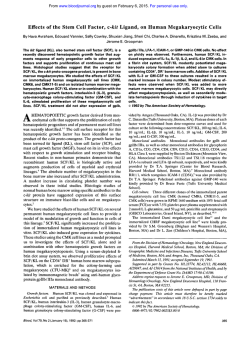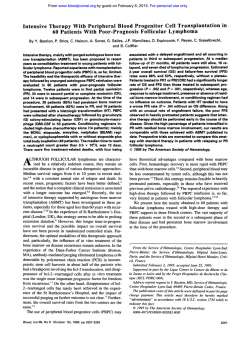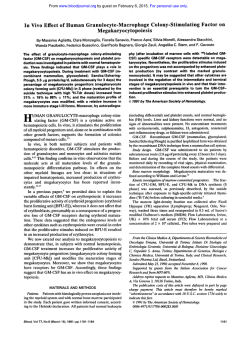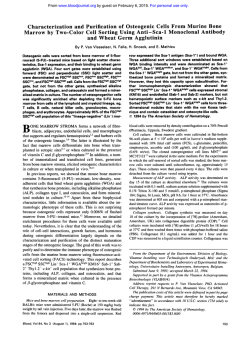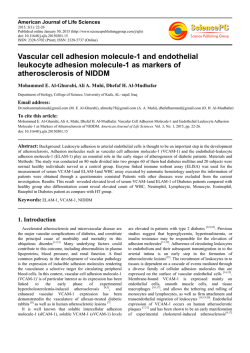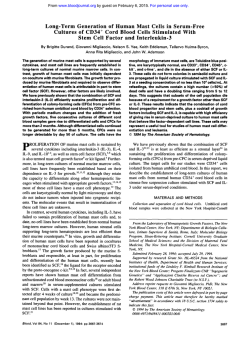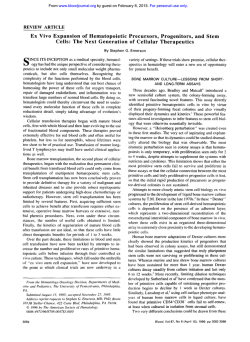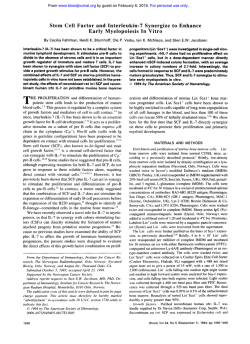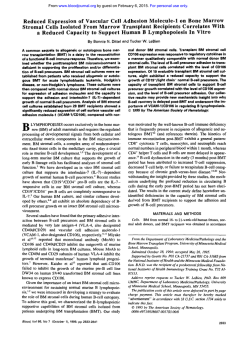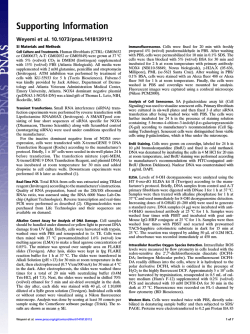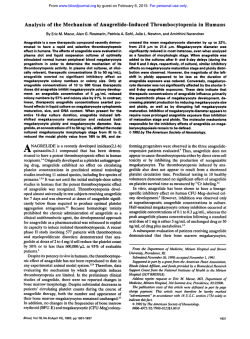
Interaction of Human Bone Marrow Fibroblasts With
From www.bloodjournal.org by guest on February 6, 2015. For personal use only. Interaction of Human Bone Marrow Fibroblasts With Megakaryocytes: Role of the c-kit Ligand By Hava Avraham, David T. Scadden, Sherry Chi, Virginia C. Broudy, Krisztina M. Zsebo, and Jerome E. Groopman Human kit ligand (KL), also known as stem cell factor (SCF), steel factor, or mast cell growth factor, is a recently identified hematopoietic growth factor whose receptor is the product of the c-kit proto-oncogene. Alternative splicing of the premRNA of KL/SCF results in secreted and membrane-bound forms of the protein. We and others have recently shown that the c-kit gene product is expressed on human megakaryocytes and that soluble KL/SCF in combination with granulocyte-macrophage colony-stimulating factor, interleukin-3 (IL3). or IL-6 increased megakaryocyte progenitor colony formation (CFU-MEG) and stimulated mature megakaryocytes. Here we show that adhesion of human megakaryocytes t o bone marrow stromal fibroblasts, which express the membrane-bound form of KL/SCF (mKL/SCF), is mediated in part by the interaction between mKL/SCF and the c-kit protein. This interaction also results in marrow fibroblaststimulated proliferation but not an increase in ploidy of megakaryocytes; when the t w o cell types were separated by a transoluble membrane, proliferation did not occur. Adhesion and proliferation of human megakaryocytesto an immortalized murine stromal cell line SI/SI lacking the KL/SCF gene was impaired, whereas transfection of SI/SI cells with human mKL/SCF significantly increased both adhesion and proliferation. Marrow stromal fibroblast mKL/SCF may serve both as an adhesion structure and as a growth-potentiating factor for megakaryocytes in the bone marrow. 0 1992by The American Society of Hematology. T be anchored to stromal elements within the bone marrow microenvironment and positioned to respond to cytokines. HE HUMAN kit ligand (KL), also known as stem cell factor (SCF), mast cell growth factor, or steel factor has recently been identified as the product of the S1 The cell surface receptor for KL/SCF is the product of the c-kit proto-oncogene. Mice with mutations in the SI locus have abnormalities in hematopoiesis, germ cells, and melanocytes. Two forms of KL/SCF have been described that arise through differential RNA processing: a membranebound species and a soluble secreted form.3 Soluble KL/ SCF in vitro increased the growth response of progenitor cells to later-acting cytokines such as interleukin-3 (IL-3), erythropoietin, and granulocyte colony-stimulating factor (G-CSF).1-3 It has recently been observed that colonyforming unit-megakaryocyte progenitors (CFU-Meg) and mature human megakaryocytes proliferated in response to soluble recombinant KL/SCF.4,5 Cos cells expressing surface murine KL/SCF adhered with murine mast cells: suggesting that the membranebound molecule may have a different function from the soluble species. A study of murine mast cell adhesion to mesenchymal cells derived from Sl/Sl mice found that the extracellular domain of mKL/SCF was required to mediate this adhesion.’ The interaction of human megakaryocytes with adhesion molecules present on bone marrow stromal cells has not been defined. To explore the potential role of mKL/SCF as an adhesion structure for megakaryocytes and other c-kit expressing hematopoietic cells, we studied adhesive interactions of human megakaryocytic cells with bone marrow stromal fibroblasts. Our studies showed that adhesion of human megakaryocytes could be mediated in part via their c-kit receptor binding to membrane-associated KL/SCF expressed by bone marrow fibroblasts. Further, direct interaction between stromal fibroblasts and megakaryocytes induced DNA synthesis as measured by thymidine incorporation in the megakaryocytic cells. The dual function of mKL/SCF as both an adhesion structure and a regulator of proliferation is novel among hematopoietic growth factors, and provides a model whereby hematopoietic cells, such as megakaryocytes, mast cells, and early hematopoietic progenitors may Blood, Vol80, No 7 (October I), 1992: pp 1679-1684 MATERIALS AND METHODS Cells. Human bone marrow was obtained by aspiration from the iliac crest of normal donors who gave informed consent in a protocol approved by the New England Deaconess Hospital Institutional Review Board. The marrow was aspirated into preservative-free heparin (Sigma Chemical CO, St Louis, MO) and separated by centrifugation through Ficoll-Hypaque (Pharmacia, Piscataway, NJ) at 1,200g at room temperature for 30 minutes. After two washes with sterile lx phosphate-buffered saline (PBS), the cells were resuspended in Iscove’s modified Dulbecco’s medium (IMDM) with 20% fetal calf serum (FCS), penicillin/ streptomycin (PIS), and L-glutamine; seeded onto T-75 tissue culture flasks (Corning, Corning, NY);and incubated at 37°C in 5% COz. After 48 hours, the nonadherent cells were gently removed, and the adherent cells were refed with fresh media, The cells were refed with fresh medium every 3 days and trypsinized and split after 1 week or when confluent. Cells underwent three cycles of trypsinization and splitting before characterization or use in experimental protocols. Cultures of marrow stromal fibroblasts prepared by this method were uniformly positive for vimentin, negative for cytokeratin, negative for von Willebrand’s factor, and negative for nonspecific esterase by immunochemical or histochem- From the Division of HematologyIOncoIogy, Department of Medicine, New England Deaconess Hospital, Harvard Medical School, Boston, 11.24; the Division of Hematology, University of Washington, Seattle, WA; and Amgen, Inc, Thousand Oaks, CA. Submitted February 20,1992; accepted June 8, 1992. Supported in part by grants from the National Institutes of Health HL33774, HL42112, HL43510, HL46668, AI-29847, CA5.5520, and the Department of Defense 17-90-CO106. Presented in part at the meeting of the American Society of Hematology, December 1991, Denver, CO. Address reprint requests to Jerome E. Groopman, MD, New England Deaconess Hospital, Division of HematologylOncologv, I I O Francis St, Suite 4A, Boston, 11.24 02215. The publication costs of this article were defrayed in part by page charge payment. This article must therefore be hereby marked “advertisement” in accordance with I8 U.S.C.section I734 solely to indicate this fact. 0 1992 by The American Society of Hematology 0006-4971I92 l8007-0006$3.00/0 1679 From www.bloodjournal.org by guest on February 6, 2015. For personal use only. AVRAHAM ET AL 1680 ical staining. Human marrow megakaryocytes were isolated by a method employing immunomagneticbeads using antihuman glycoprotein GPllbIllla monoclonal antibody (MoAb) as described previously! All of the isolated cells were recognizable as megakaryocytes by morphology and/or specific immunofluorescence using antiplatelet antibodies, GPllbIllla, and Gplb. H9 T cells were obtained from Dr Robert Gallo. the National Cancer Institute, and cultured in RPMI 1640 medium with 10% FCS, PIS, and Lglutamine. The CMK cell line, provided by Dr T. Sat0 and derived from a child with megakaryoblastic leukemia, has properties of cells of megakaryocytic lineage, including surface expression of glycoproteins Ib and Ilb/llla, synthesis of platelet factor 4. platelet derived growth factor, von Willebrand factor. and becomes polyploid on induction with phorbol esters.".l" No myeloid or lymphoid surface markers have been found on our cultured CMK cells. The CMK cell line was cultured in RPMI 1640 + 10% FCS. An immortalized stromal fibroblast cell line derived From the fetal hematopoietic microenvironment of a murine homozygous (SIISI) embryo that lacks the entire coding sequence of the Steel gene has been derived." This stromal cell line (SI/SI) has been used for the transfection of a cDNA encoding a 220 amino acid SCF protein (hSCF2x') lacking the proteolytic cleavage site because of the exclusion of exon 6 by Toksoz et al." Therefare. the 220-amino acid polypeptide remains membrane-bound in the transfected SIISI cells. Neither the original cell line (SIISI) nor transfectants containing the 220 cDNA (SI/SI-SCF2x') secreted detectable amounts of KLISCF. The SI/SI-hSCF22"transfectant showed a high level of membrane-associated hKLISCF protein as measured by FlTC goat antimouse staining of cells labeled with a primary MoAb to human KLISCF." Cell-cell adhesion assay. To measure cell-cell adhesion, lo( CMK cells or bone marrow megakaryocytes in 2 mL of Dulbecco's modified Eagle's medium (DMEM) with 10% FCS were added to marrow stromal fibroblasts. The cells were allowed to settle for I hour at 37°C. followed by swirling to redistribute the floating cells and the cells were resettled for an additional hour. Following c-kit 1 1 PCR Analysis Southern Blot A B settling of the cells, nonadherent cells were then washed away in four changes of medium, centrifuged at 1,500 rpm for 10 minutes and counted. The adherent megakaryocytes were quantitated by dislodging them by vigorous pipeting up and down and then counting with Trypan blue. For inhihition studies, we used the following specific antibodies: control IgG ascites (at dilution 1:l.OOO); purified SR-I MoAb, which recognizes the human KLI SCF receptor c-kit (at dilution of 100 ng/mL)I2; purified control IgG ascites (at dilution of 100 ngImL); MoAbs TSlI22 and TSI 118. which recognize the LFA-la subunit and LFA-IS subunit. respectively (Dr T.A. Springer, Center For Blood Research, Harvard Medical School, Boston, MA); and MoAb RRIII, which recognizes ICAM-I (CD54) (also provided by Dr T.A. Springer). MoAbs to human GPlb, GPIlb/Illa, and L e u 4 were obtained from Becton Dickinson (Mountain View, CA). All MoAbs were used at a dilution of 1:lOO. To assay inhibition of adhesion, cells were treated (30 minutes, 37°C) with the relevant antibody, as indicated in the text. After 30 minutes, the cells were washed three times with PBS and then added to stromal fibroblast monolayers with incubation for 1 hour at 37°C. Nonadherent cells were removed and the remaining adherent cells were collected, trypsinized, and counted as described above. RNA and DNA analysis. RNA was isolated by the guanidium isothiocyanate method. First-strand cDNA was synthesized at 37°C for 1 hour in a final volume of 10 pL with oligo-dT as primers; 4.S pL RNA in DEPC-dH20, 2.0 pL 5 x buffer (250 mmolIL Tris-HCI, pH 8.3.375 mmolIL KCI, SO mmolIL dithiothreitol, 15 mmolIL MgC12, and 250 pg/mL actinomycin D), 0.5 pL RNAsin (40 U/pL, Promega, Madison, WI), 1.0 pL dNTP (dATP, dCTP, dGTP, dTTP mix, 10 mmolIL each (Pharmacia), 1.0 pL oligo-dT, 1.0 pL Maloney murine leukemia virus (MMLV) reverse transcriptase (2,000 UImL, Boehringer-Mannheim, Chicago, IL). Polymerase chain reacrion (PCR). Eighty microliters of PCR mix was added to 10 pL of first-strand cDNA. PCR mix contains: 53.5 pL sterile water, 10 pL 10 x buffer, 16 pLof dNTP mix (each at 1.25 mmolIL) and 0.5 pL (2.5 U) of the Themus aqitariars thermostable DNA polymerase (Cetus-Perkin Elmer, Emeryville, SCF PCR Analysis Southem Blot C D Fig 1. PCR analpis of c-kit and KL/SCF cDNAs from megakaryocytes, CMK cells, H9 T-cells, and bone marrow fibroblasts. PCR was performed on cDNA preparedfrom RNA isolatedfrom the indicated source of cells as described. The PCR products were separated on 2% or 1% agarose gels (c-kit and KL/SCF, respectively) run in Tris-borate EDTA buffer (TBE) containing 0.25% pgImL ethidium bromide. Southern blot hybridizationof the PCR productswas performedusing specific probesfor e-kit and KLISCF. The probe of KL/SCF was generatedby linearizing pGEM3:hKL/SCF no. 9 with EcoRI-Hindlll using the 218-bp insert as a probe. The probe of c-kit was generated by linearizing phc-kit 171 with Sstl and using the 1.25-kb insert as a probe5 From www.bloodjournal.org by guest on February 6, 2015. For personal use only. KIT LIGAND MEDIATES MEGAKARYOCME ADHESION -, ,- Adhesion 7 SCF TreatmentI- : 1681 Statistical analysis. The results were expressed as the mean -C SEM of data obtained from three or more experiments performed in duplicate or four replicate, as indicated in the text. Statistical significance was determined using the Student's t-test. 20 RESULTS c 0 10 Adhesion of megakatyocytes to bone marrow fibroblasts. CMK cells and isolated human megakaryocytes expressed the c-kit proto-oncogene (Fig 1A and B). Bone marrow stromal fibroblasts expressed mRNAs related to both the A r Untreated McA CMK Cells c b C@n'vl Ascttes Hours Minutes E F LAscites IgG GplbGpIlbflIIaLFA-1 h Leu8 I C-klt i+ -I c.kll + G n l l h / l l I ~ Human Isolated Meg. Untreated Fig 2. Adhesion of megakaryocytes to bone marrow fibroblasts. (A,C) Adherent CMK cells or marrow megakaryocyteswere counted in cytocentrifugepreparations stained with trypan blue. (B,D) CMK cells or marrow megakaryocytes were treated with human recombinant soluble KL/SCF (50 ng/mL) for 24 hours. The cells were washed and then added to the bone marrow fibroblast monolayers for 1 hour to permit adhesion. Values are mean f SEM, n = 8. Adhesion was significantly inhibited by soluble SCF/KL treatment, P c .05. (E) Photograph of clusters of isolated marrow megakaryocyte adherent to bone marrow fibroblasts. (F) Photograph of isolated marrow megakaryocytes pretreatedwith human recombinant soluble KL/SCF (50 ng/mL) for 24 hours. There is minimal adhesion to the bone marrow fibroblasts. Bone marrow fibroblast cells are visible as having fibroblast-like morphology and megakaryocytes as small round refractile cells. CA).'O Five microliters of each primer was added to give a final primer concentration of 1 pmol/L, and the mixture was then subjected to PCR amplification using the Perkin Elmer thermal cycler set for 40 cycles. The temperatures used for PCR were: denature 94°C. 1 minute; primer anneal 55°C. 2 minutes; primer extension 72"C, 3 minutes. Normally, 1-minute ramp times were used between these temperatures. The specific primers for c-kit and KLlSCF were obtained from Amgen (Thousand Oaks, CA). Southern blotting was performed by standard procedures. The hybridization step was carried out in 50% formamide at 42°C. The probe of KLlSCF was generated by linearizing pGEM3:hSCF#9 with EcoRI-Hind111using the 218 insert as a probe. The probe of c-kit was generated by linearizing phc-kit 171 with Sstl and using the 1.25-kb insert as a probe. Assay of 17H] thymidine uptake by cultured cells. DNA synthesis and cell viability were respectively assessed by ['HI thymidine incorporation and by Trypan blue exclusion (0.4% Trypan blue stain in 0.85% saline; GlBCO Laboratories, Grand Island, NY). Cells were pulsed with 0.5 pCi per well of [-'HI thymidine (New England Nuclear, Boston, MA) and incubated for an additional 5 hours. Samples were harvested onto glass fiber filters washed with saline and then counted by liquid scintillation spectrometry. Quantitation of viable cell number by Trypan blue exclusion thymidine incorporation. confirmed proliferation results with [3H] Control Ascites LAscites IgG 20 0 200 100 ki a 2 200 40 60 4% 80 99 % - 4 1 CMK Cells \i 8% 3 a 82 % 1 1 Human Isolated Meg. 1 Fluorescence lntensity Fig 3. (A) Effects of specMc antibodies against c-kit, GPllb/llla, GPlb, LFA-1, and Leu 8 on adhesion of megakaryocytic cells to bone marrow fibroblasts. CMK cells or isolated marrow megakaryocytes were incubated without antibodies, or with MoAbs for GPlb, GPllb/ Illa, LFA-1, Leu 8, or c-kit for 30 minutes at 37°C. The cells were then washed and added to bone marrow fibroblasts for 1 hour at 37°C. Values are mean f SEM, n = 6. Adhesion was significantly inhibited, P c .05, compared with control. (B) Immunofluorescence analysis using flow cytometry of CMK cells or isolated marrow megakaryocytes stained with specific antibodiesfor e-kit. CMK cells or megakaryocytes were incubated with purified control IgG ascites (100 ng/mL) or purified SR-1 antibody (100 ng/mL), which recognizes human c-kit. Cells, 105, were analyzed in each instance and fluorescence intensity was displayed in relative intensity on a logarithmic scale. Percentage of positive cells, calculated between channel numbers 50 and 200, are indicated. An unrelated FITC-labeled conjugate (Swine antirabbit Ig) stained about 2% of each suspension (curves not shown). From www.bloodjournal.org by guest on February 6, 2015. For personal use only. AVRAHAM ET AL 1682 soluble and membrane forms of KL/SCF (Fig 1C and D). Low but detectable amounts of secreted soluble KL/SCF ( 0.3 ng/mL) were measured using a radioreceptor binding assay in the conditioned media of stromal fibroblasts.' Incubation of CMK megakaryocytic cells with primary bone marrow stromal fibroblasts resulted in adhesion of the normally nonadherent CMK cells to the fibroblast monolayer. This interaction was rapid and was observed after 15 minutes (Fig 2A). Addition of soluble recombinant human KL/SCF at concentrations of 50 ng/mL inhibited subsequent adhesion of CMK cells to the fibroblasts (Fig 2A and B). Adhesion also occurred between isolated human marrow megakaryocytes and bone marrow stromal fibroblasts. These studies showed adhesion of marrow megakaryocytes within 30 minutes that persisted for more than 24 hours (Fig 2C and E). Treatment with soluble recombinant KL/SCF (at 50 ng/mL) for 24 hours inhibited adhesion of marrow megakaryocytes to stromal fibroblasts (Fig 2D and F). Inhibition of adhesion was also observed on pretreatment of CMK cells or marrow megakaryocytes with the SR-1 neutralizing MoAb to c-kit,'* but not in control cultures treated with an irrelevant MoAb of the same isotype, the control IgG ascites, or a control MoAb to HLA surface antigen (Fig 3A). Flow cytometry of CMK cells or marrow megakaryocytes treated with the anti-c-kit SR-1 antibody showed that 99% and 83%, respectively, stained positively (Fig 3B). Adhesion was also inhibited by pretreatment of stromal fibroblasts with polyclonal anti-KL/SCF antibodies, but not with control rabbit serum (data not shown). - Isolated Bone Marrow Megakaryocytes CMK 1 I 1 I I A To ascertain which other cell surface adhesion molecules could mediate cell-cell interaction between CMK cells and the marrow fibroblasts, cross-blocking cell adhesion experiments were performed using inhibitory MoAbs specific for the LFA-1 complex, GPIIblIIIa, GPIb, and Leu 8 struct u r e ~ . 'MoAbs ~ to LFA-1, GPIb, GPIIb/IIIa, and Leu 8 blocked adhesion of CMK cells. The combination of these MoAbs with the SR-1 antibody to c-kit antibodies resulted in a small increase in inhibition of adhesion of CMK cells (Fig 3A). To further confirm that the mKL/SCF and c-kit interaction mediated adhesion and that the anti-c-kit antibody was not simply sterically blocking interactions involving other adhesion molecules on the megakaryocyte cell surface, two approaches were used. First, Fab-specific antibodies against c-kit, GPIIb/IIIa, GPIb, and LFA-1 were prepared and tested for their effects on adhesion. These Fab antibodies inhibited adhesion of CMK cells comparable to that seen with the intact MoAbs (data not shown). The second approach involved immunofluorescence analysis by flow cytometry of CMK cells using specific antibodies for c-kit, LFA-1, Leu 8, GPIIb/IIIa, and GPIb. In these experiments, CMK cells were first stained with the SR-1 MoAb to c-kit. The immunofluorescence staining of these other adhesive molecules on CMK cells treated with SR-1 was confirmed by flow cytometry (data not shown). Thus, each neutralizing MoAb was able to interact with its adhesion molecule on the cell surface even in the presence of SR-1 binding to c-kit. Taken together, these observations suggested that c-kit and mKL/SCF interactions were directly mediating adhe- 1 0 Meg. Co-cultured Meg.tBMF D CMofMeg. Add to BMF E CMofBMF -5 Add to Meg, 4 n.d. F 9 m 10 Co-cultured with membrane 1 24 48 72 1 Time of Culture ( h ) 24 48 72 Fig 4. Stimulation of DNA synthesis measured by [JH]thymidine incorporationin megakaryocytic cells cocultured with bone marrow fibroblasts. Isolated human megakaryocytes or CMK cells were added to a subconfluent bone marrow fibroblast (BMF) monolayer in 24-well plates (Costar, Cambridge, MA). After the indicatedcoculture time, the entire coculture was assayed for PHI thymidine uptake over a 5-hour period. Each assay was performed on duplicate wells. Results are given as means f SEM and are the pooled results of four independent experiments. 'Significantly elevated in the cocultures compared with the bone marrow fibroblasts, CMK cells, or isolated megakaryocytes alone (columns A plus 6, P < .(E).*Significantly elevated compared with the sum of the conditioned media (CM) results (columns D plus E, P < .05). 3Significantly elevated compared with cocukure separated by a transoluble membrane (column F, P < .05). From www.bloodjournal.org by guest on February 6, 2015. For personal use only. KIT LIGAND MEDIATES MEGAKARYOCYTE ADHESION sion and additional adhesive molecules, such as GPIIbl IIIa, LFA-1, and Leu 8, also can participate in the adhesion process between megakaryocytes and marrow fibroblasts. DNA synthesis in megakaryocytes. Additional experiments were performed to determine whether adhesion of bone marrow fibroblasts and CMK cells or isolated marrow megakaryocytes triggered DNA synthesis in these cells (Fig 4). In a coculture assay, bone marrow fibroblasts were incubated directly with CMK cells or isolated megakaryocytes. Stimulation of marrow megakaryocyte [3H]thymidine uptake was observed. Similar stimulation, though of a much lesser magnitude, was seen with the permanent CMK cell line, which grows autonomously. CMK cells or human megakaryocytes alone, bone marrow fibroblasts alone, bone marrow fibroblasts incubated in CMK or megakaryocyte conditioned media, or isolated megakaryocytes or CMK cells cultured in media conditioned by marrow fibroblasts did not achieve similar levels of [3H]thymidine incorporation. In addition, CMK cells or marrow megakaryocytes cultured in the presence of marrow fibroblasts but separated by a transoluble membrane filter did not show augmented [3H] thymidine incorporation, indicating that direct contact was required for DNA synthesis and proliferation. Quantitation of viable cell number by Trypan blue exclusion confirmed proliferation results with [3H] thymidine incorporation (data not shown). Attachment of CMK cells or megakaryocytes to marrow fibroblasts resulted in cell division not nuclear endoreduplication. In addition, these experiments were repeated with irradiated bone marrow fibroblasts. The results were similar to that of nonirradiated bone marrow fibroblasts (data not shown). Adhesion of megakaryocytes to Sl/Sl-hSCF220. Another approach to further show that the membrane form of fibroblast KLiSCF mediated megakaryocyte adhesion was pursued. In a coculture assay, CMK or marrow megakaryocytes were incubated directly with murine SI/Sl cells or SI/SI-hSCPZ0, then floating megakaryocytic cells were washed away and the numbers of adherent cells determined. Megakaryocytes showed marked adhesion and spreading within 30 minutes and a maximal degree of adhesion was reached after 3 hours (54% f 9%; mean t SEM of five experiments). Only a small number of megakaryocytes adhered to the nontransfected murine SliSl cells (21% ? 7%; mean f SEM of five experiments), even after longer incubation times. The difference in adhesion of megakaryocytes to SI/SI-hSCFZz0compared with parent murine SliSl cells was statistically significant (P < .05). These results indicated that murine SI/SIhSCFZ2O cells, which expressed the membrane form of human KL/SCF, promoted adhesion of human megakaryocytes, whereas parental murine SliSl cells did not. Increased [3H] thymidine incorporation was observed in cocultures of adherent CMK cells or marrow megakaryocytes and irradiated S1/SI-hSCFZz0cells, but not with irradiated parental Sl/Sl cells (Fig 5), showing that direct interaction of c-kit and mKL/SCF resulted in DNA synthesis in the megakaryocytic cells. 1683 1 Fibroblasts 1 Co-cultured cells1 0 Isolated Bone Marrow Meg. -15 - -10 - -5 5.- E F z 0 Fig 5. Stimulation of DNA synthesis measured by 3[H] thymidine incorporation in megakaryocytic cells cocultured with SI/SI or SI/SIhKL/SCFzzOfibroblast cells. Isolated human megakaryocytes or CMK cells (referred to as MEG in figure) were added to a subconfluent irradiatedfibroblast monolayer (3 Gy), in 24-well plates (Costar).After 72 hours, the entire coculture was assayed for [3H]thymidine uptake. Each assay was performed on four replicate wells in six different experiments. Results are given as means f SEM. Megakaryocytes cocultured with SI /SI-hKL/SCF" gave incorporation significantly above the SI/SI cocultured system with P c .01. There was no significant difference in thymidine incorporation in CMK cells alone compared with CMK cells cocultured with nontransfectedSI/SI cells. DISCUSSION Our results show that human megakaryocytes can adhere to bone marrow stromal fibroblasts, which results in induction of DNA synthesis in the megakaryocytes. This adhesion may be mediated in part by the specific interaction of the c-kit product on the megakaryocyte cell surface with the membrane-associated form of KL/SCF on the marrow fibroblast. This conclusion is based on the observations that treatment of megakaryocytes with soluble recombinant KL/SCF inhibited this adhesion, and that inhibition of adhesion was also observed with the SR-1 antibody to c-kit or with polyclonal antibodies to IU/SCF. Direct cell-cell interaction of megakaryocytes with stromal fibrobIasts was required for DNA synthesis in the megakaryocytes, as shown by the coculture studies. This was most clearly seen using primary bone marrow megakaryocytes, which are likely to be more physiologically relevant compared with the immortalized CMK cell line. During the course of our experiments, two other research groups presented data indicating that the product of the Steel gene may mediate mast cell adhesion. Flanagan et a16 transfected cos cells with murine KL/SCF and observed aggregation of murine mast cell lines. Kaneko et a17 also reported murine mast cell adhesion with the extracellular domain of IUISCF. Our work addressed the functions of membrane-associated human KLiSCF in the context of megakaryocytopoiesis. The bone marrow stromal microen- From www.bloodjournal.org by guest on February 6, 2015. For personal use only. AVRAHAM ET AL 1684 vironment may serve a number of functions in megakaryocyte growth and maturation, acting as a support framework for developing progenitor cells as well as a rich source of growth factors.14J5Expression of alternative forms of KL/ SCF by stromal fibroblasts may be a point of regulation of megakaryocytes and other c-kit expressing cells, because such hematopoietic cells may use this surface structure as a n adhesion molecule. Furthermore, direct interaction of mKL/SCF with t h e c-kit receptor may result in potentiation of cell growth, particularly in conjunction with other cytokines such as IL-3, IL-6, and granulocyte-macrophage CSF.4,5J6 The dual function of mIU/SCF-mediating megakaryocyte adhesion and proliferation-is novel among the hematopoietic growth factors reported to modulate cells of this lineage.15 Whether adhesion and proliferation are regulated by independent functional domains within m a / SCF or its receptor, c-kit, is subject t o further study. ACKNOWLEDGMENT We thank Dr T.A. Springer (Harvard Medical School, Boston, MA) for providing the LFA-1 MoAbs, Dr D. Williams and Dr Denise Toksoz for providing us with the SI/SI and SI/SI-hSCF2” cell lines, Dr Larry Bennett for assaying soluble KL/SCF and providing anti-KL/SCF antibody, and Patricia Grynkiewicz for preparation of the manuscript. REFERENCES 9. Komatsu N, Suda T, Moroi M, Tokuyama N, Sakato Y, 1. Zsebo KM, Williams DA, Geissler EN, Broudy VC, Martin Okada M, Nishida T, Hirai Y, Sat0 T, Fuse A, Miura Y: Growth FH, Atkins HL, Hsu RY, Birket NC, Okino KH, Murdock DC, and differentiation of a human megakaryohlastic cell line, CMK. Jacobsen FW,Langley KE, Smith KA, Takeishi T, Cattanach BM, Blood 74:42,1989 Galli SJ, Suggs SV: Stem cell factor is encoded at the SI locus of the mouse and is the ligand for the c-kif tyrosine kinase receptor. Cell 10. Avraham HA, Vannier E, Chi SY, Dinarello CA, Groopman 63:213, 1990 JE: Cytokine gene expression and synthesis by human megakaryo2. Huang E, Nocka K, Beier DR, Chu T-Y, Buck J, Lahm H-W, cytic cells. Int J Cell Cloning 1070,1992 Wellner D, Leder P, Besmer P: The hematopoietic growth factor 11. Toksoz D, Birkett N, Smith K, Zsebo K, Williams D A KL is encoded at the SI locus and is the ligand of the c-kif receptor, Analysis of activity of 2 distinct forms of the steel gene product the gene product of the Wlocus. Cell 63:225,1990 (steel factor-SCF) expressed in deficient murine stromal cell lines. 3. Anderson DM, Lyman SD, Baird A, Wignall JM, Eisenman J, Blood 78:160a, 1991 (abstr) Rauch C, March CJ, Boswell HS, Gimpel SP, Cosman D, Williams 12. Broudy VC, Lin N, Zsebo KM, Birkett NC, Smith KA, DE: Molecular cloning of mast cell growth factor, a hematopoietin Bernstein ID, Papayannopoulou T Isolation and characterization that is active in both membrane bound and soluble forms. Cell of a monoclonal antibody that recognizes the human c-kit receptor. 63:235,1990 Blood 79:338,1992 4. Avraham H, Vannier E, Cowley S , Jiang S, Chi S, Dinarello 13. Springer TA Adhesion receptors of the immune system. CA, Zsebo KM, Groopman JE: Effects of stem cell factor, c-kif Nature 346:425, 1990 ligand, on human megakaryocytic cells. Blood 79:365,1992 14. Dexter TM, Moore MAS: In vitro duplication and cure of 5. Briddell PA, Bruno E, Cooper RJ, Brandt JE, Hoffman R: hematopoietic defects in genetically anemic mice. Nature 269:412, Effect of c-kit ligand on in vitro human megakaryocytopoiesis. 1977 Blood 78:2854,1991 15. Hoffmann R: Regulation of megakaryocytopoiesis. Blood 6. Flanagan JG, Chan D, Leder P: Transmembrane form of the 74:1196, 1989 kit ligand growth factor can be regulated by alternative splicing and 16. Miyazawa K, Henrie PC, Mantel C, Wood K, Ashman LK, is deleted in the SI mutant. Cell 64:1025, 1991 Broxmeyer HE: Comparative analysis of signaling pathways be7. Kaneko Y, Takenawa J, Yoshida 0, Fujita K, Sugimoto K, tween mast cell growth factor (c-kit ligand) and granulocyteNakayama H, Fujita J: Adhesion of mouse mast cells to fibroblasts: macrophage colony-stimulating factor in a human factor-depenAdverse effectsof steel (SI) mutation. J Cell Physiol 147:224, 1991 dent myeloid cell line involves phosphorylation of Raf-1, GTPase8. Tanaka H, Ishida Y, Kaneko T, Matsumoto N: Isolation of activating protein and mitogen activated protein kinase. Exp human megakaryocytes by immunomagnetic beads. Br J Haematol Hematoll9:1110, 1991 73:18, 1989 From www.bloodjournal.org by guest on February 6, 2015. For personal use only. 1992 80: 1679-1684 Interaction of human bone marrow fibroblasts with megakaryocytes: role of the c-kit ligand H Avraham, DT Scadden, S Chi, VC Broudy, KM Zsebo and JE Groopman Updated information and services can be found at: http://www.bloodjournal.org/content/80/7/1679.full.html Articles on similar topics can be found in the following Blood collections Information about reproducing this article in parts or in its entirety may be found online at: http://www.bloodjournal.org/site/misc/rights.xhtml#repub_requests Information about ordering reprints may be found online at: http://www.bloodjournal.org/site/misc/rights.xhtml#reprints Information about subscriptions and ASH membership may be found online at: http://www.bloodjournal.org/site/subscriptions/index.xhtml Blood (print ISSN 0006-4971, online ISSN 1528-0020), is published weekly by the American Society of Hematology, 2021 L St, NW, Suite 900, Washington DC 20036. Copyright 2011 by The American Society of Hematology; all rights reserved.
© Copyright 2025
